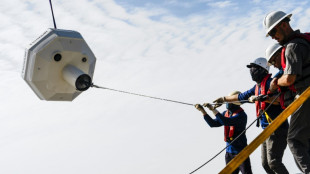
-
 Demand for Japanese content booms post 'Shogun'
Demand for Japanese content booms post 'Shogun'
-
As India's Bollywood shifts, stars and snappers click

-
 Mystery drones won't interfere with Santa's work: US tracker
Mystery drones won't interfere with Santa's work: US tracker
-
Djokovic eyes more Slam glory as Swiatek returns under doping cloud

-
 Australia's in-form Head confirmed fit for Boxing Day Test
Australia's in-form Head confirmed fit for Boxing Day Test
-
Brazilian midfielder Oscar returns to Sao Paulo

-
 'Wemby' and 'Ant-Man' to make NBA Christmas debuts
'Wemby' and 'Ant-Man' to make NBA Christmas debuts
-
US agency focused on foreign disinformation shuts down

-
 On Christmas Eve, Pope Francis launches holy Jubilee year
On Christmas Eve, Pope Francis launches holy Jubilee year
-
'Like a dream': AFP photographer's return to Syria

-
 Chiefs seek top seed in holiday test for playoff-bound NFL teams
Chiefs seek top seed in holiday test for playoff-bound NFL teams
-
Panamanians protest 'public enemy' Trump's canal threat

-
 Cyclone death toll in Mayotte rises to 39
Cyclone death toll in Mayotte rises to 39
-
Ecuador vice president says Noboa seeking her 'banishment'

-
 Leicester boss Van Nistelrooy aware of 'bigger picture' as Liverpool await
Leicester boss Van Nistelrooy aware of 'bigger picture' as Liverpool await
-
Syria authorities say armed groups have agreed to disband

-
 Maresca expects Man City to be in title hunt as he downplays Chelsea's chancs
Maresca expects Man City to be in title hunt as he downplays Chelsea's chancs
-
South Africa opt for all-pace attack against Pakistan

-
 Guardiola adamant Man City slump not all about Haaland
Guardiola adamant Man City slump not all about Haaland
-
Global stocks mostly higher in thin pre-Christmas trade

-
 Bethlehem marks sombre Christmas under shadow of war
Bethlehem marks sombre Christmas under shadow of war
-
11 killed in blast at Turkey explosives plant

-
 Indonesia considers parole for ex-terror chiefs: official
Indonesia considers parole for ex-terror chiefs: official
-
Postecoglou says Spurs 'need to reinforce' in transfer window

-
 Le Pen says days of new French govt numbered
Le Pen says days of new French govt numbered
-
Villa boss Emery set for 'very difficult' clash with Newcastle

-
 Investors swoop in to save German flying taxi startup
Investors swoop in to save German flying taxi startup
-
How Finnish youth learn to spot disinformation

-
 12 killed in blast at Turkey explosives plant
12 killed in blast at Turkey explosives plant
-
Panama leaders past and present reject Trump's threat of Canal takeover

-
 Hong Kong police issue fresh bounties for activists overseas
Hong Kong police issue fresh bounties for activists overseas
-
Saving the mysterious African manatee at Cameroon hotspot

-
 India consider second spinner for Boxing Day Test
India consider second spinner for Boxing Day Test
-
London wall illuminates Covid's enduring pain at Christmas

-
 Poyet appointed manager at South Korea's Jeonbuk
Poyet appointed manager at South Korea's Jeonbuk
-
South Korea's opposition vows to impeach acting president

-
 The tsunami detection buoys safeguarding lives in Thailand
The tsunami detection buoys safeguarding lives in Thailand
-
Teen Konstas to open for Australia in Boxing Day India Test

-
 Asian stocks mostly up after US tech rally
Asian stocks mostly up after US tech rally
-
US panel could not reach consensus on US-Japan steel deal: Nippon

-
 The real-life violence that inspired South Korea's 'Squid Game'
The real-life violence that inspired South Korea's 'Squid Game'
-
Blogs to Bluesky: social media shifts responses after 2004 tsunami

-
 Tennis power couple de Minaur and Boulter get engaged
Tennis power couple de Minaur and Boulter get engaged
-
Supermaxi yachts eye record in gruelling Sydney-Hobart race

-
 Hawaii's Kilauea volcano erupts, spewing columns of lava
Hawaii's Kilauea volcano erupts, spewing columns of lava
-
El Salvador Congress votes to end ban on metal mining

-
 Five things to know about Panama Canal, in Trump's sights
Five things to know about Panama Canal, in Trump's sights
-
NBA fines Minnesota guard Edwards $75,000 for outburst

-
 Haitians massacred for practicing voodoo were abducted, hacked to death: UN
Haitians massacred for practicing voodoo were abducted, hacked to death: UN
-
Inter beat Como to keep in touch with leaders Atalanta


What we know so far about surging respiratory illnesses in China
Cases of respiratory illnesses have been surging in northern China, particularly among children, sparking speculation online of a new pandemic threat four years after Covid-19 first emerged in the country.
However Chinese health authorities have said the rising infections are a mix of already known viruses and are linked to the country's first full cold season after strict Covid restrictions were lifted last December.
And while emphasising that the full situation remains unclear, experts say there is little to suggest the cases were caused by a new virus.
Here is what we know so far.
- What and where? -
On November 13, China's National Health Commission reported a surge of respiratory illnesses, mostly in children.
Chinese authorities have attributed the rising cases to the end of Covid restrictions, the arrival of the cold season, and the circulation of known pathogens including influenza, mycoplasma pneumonia, respiratory syncytial virus (RSV) and SARS-CoV-2 -- the virus that causes Covid.
On Monday, the public disease surveillance system ProMED -- which once issued an early warning about mysterious pneumonia cases that turned out to be Covid -- reported that some Chinese hospitals were "overwhelmed with sick children" due to a pneumonia outbreak.
This outbreak was said to be mainly in the capital Beijing, but also in the northeastern Liaoning province and other areas in China.
Symptoms included fever, lung inflammation without a cough, and pulmonary nodules -- lumps on lungs that are usually the result of a past infection. No deaths have been reported.
At a children's hospital in Beijing on Thursday, several parents told AFP their children had mycoplasma pneumonia, which is a common cause of pneumonia in children that is readily treated with antibiotics.
- What do China and WHO say? -
The report triggered memories of the pandemic, with social media users fearing "a new virus coming from China," or a "new Covid".
On Wednesday, the World Health Organization -- which repeatedly criticised Beijing for a lack of transparency throughout the Covid pandemic -- requested more information from China about children suffering from "undiagnosed pneumonia".
Beijing responded on Thursday, saying "there has been no detection of any unusual or novel pathogens," according to a WHO statement.
The WHO has requested more information, noting that China closely monitors trends in viruses such as the flu, RSV and SARS-CoV-2.
China also started monitoring mycoplasma pneumonia for the first time in mid-October, the WHO added.
The WHO said that "there is limited detailed information available to fully characterise the overall risk of these reported cases of respiratory illness in children."
However an increase in such illnesses was to be expected with the arrival of winter, it added.
- What do the experts think? -
Several experts pointed to winter's arrival, the end of Covid restrictions, and a lack of prior immunity in children as likely being behind the surging infections.
"Since China experienced a far longer and harsher lockdown than essentially any other country on Earth, it was anticipated that those 'lockdown exit' waves could be substantial in China," said Francois Balloux of University College London.
Unless there is new evidence suggesting otherwise, "there is no reason to suspect the emergence of a novel pathogen," he added.
Paul Hunter of the UK's University of East Anglia emphasised that "at present there is too little information to make a definitive diagnosis".
However "overall, this does not sound to me like an epidemic due to a novel virus," he added.
"If it was, I would expect to see many more infections in adults. The few infections reported in adults suggest existing immunity from a prior exposure."
Catherine Bennett of Australia's Deakin University pointed out that "young children in school in China will have spent up to half their life without the usual exposure to common pathogens, and so do not have the same levels of immunity".
- Are there any recommendations? -
The WHO recommended that people in the affected areas follow the normal rules to avoid respiratory illnesses.
These include getting vaccinated, isolating if symptoms emerge, and getting tested or wearing masks if necessary.
Based on the current information, the WHO advised against any travel restrictions involving China.
R.J.Fidalgo--PC



